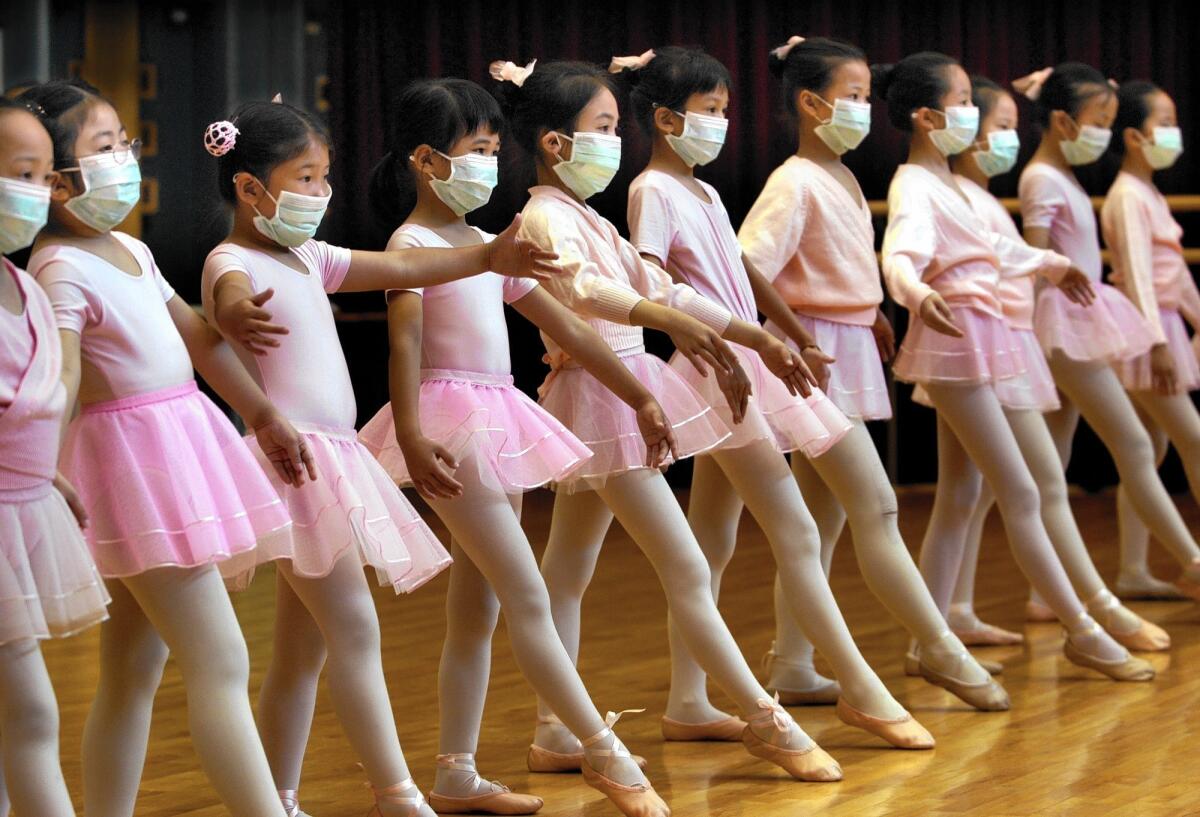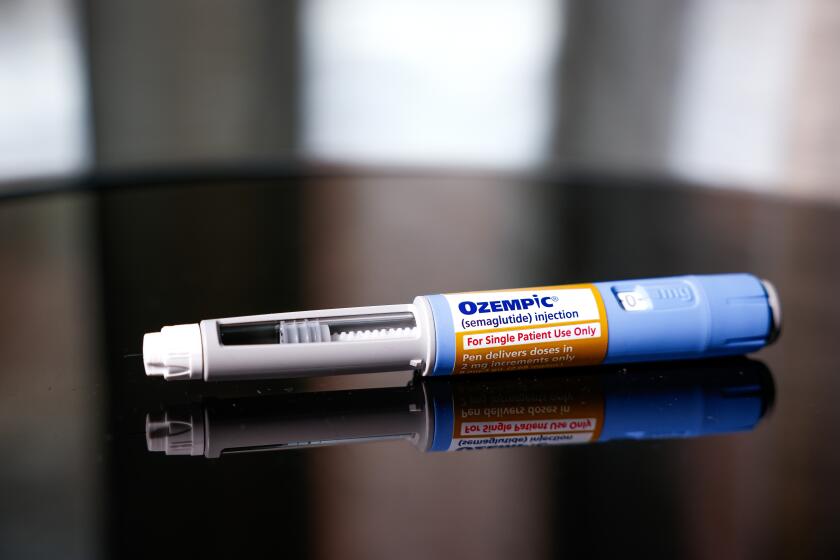More than a decade later, SARS offers lessons on Ebola

It was a novel virus whose early symptoms could easily be mistaken for a dozen other common afflictions. With no treatment or vaccine in hand, it bubbled up — and quickly mushroomed — in a group of poor, populous countries.
Healthcare workers who treated the infected died by the hundreds.
Eventually, the virus boarded airplanes and crisscrossed the globe, infecting thousands in the span of several months. Millions more came down with a paralyzing fear of the deadly and mysterious pathogen: severe acute respiratory syndrome.
Before the current outbreak of Ebola virus, there was SARS. More than a decade ago, it blew up across East Asia and spread to Canada and the United States.
The SARS outbreak, which raged for several months before it was quashed in July 2003, sickened nearly 8,500 people, claimed 900 lives and cost an estimated $40 billion to the economies it rocked.
The 21st century’s first brush with a mystery virus run amok offers plenty of lessons to physicians and public health officials racing to get ahead of Ebola.
Some measures have been adopted and have arguably altered the course of the epidemic. Others were quickly forgotten. Some have faded away as SARS receded into history.
From its origins in wild game markets in China’s Guangdong province in late 2002, SARS traveled in early 2003 to Hong Kong, then Singapore, Vietnam and North America.
The outbreak made clear that the public health of even the most developed nation rests on the ability of poorer countries to manage their disease outbreaks, said Dr. Ezekiel Emanuel, an oncologist and bioethicist at the University of Pennsylvania.
“Everybody has a stake in developing countries’ health,” said Emanuel, who wrote a widely cited report on the lessons of SARS.
U.S. funding for global health assistance, driven by President George W. Bush’s international HIV/AIDS program and the Obama administration’s focus on malaria and neglected tropical diseases, increased steadily in the wake of SARS, Emanuel said.
In recent years, the focus of U.S. health aid has shifted from treating specific diseases to building public health organizations and infrastructure in poor countries.
Those U.S. programs have already paid dividends in Nigeria and Senegal, whose fledgling public health services have successfully clamped down on Ebola’s spread.
The Ebola virus and the SARS coronavirus differ greatly. Ebola kills up to 70% of those infected, whereas SARS had a mortality rate closer to 10%. SARS, a respiratory infection, could be transmitted by exposure to airborne droplets and appears to have passed more readily from person to person than Ebola.
Still, Dr. Thomas Frieden, director of the U.S. Centers for Disease Control and Prevention, said Ebola would probably be contained in the same way as SARS: gumshoe public health work, old-fashioned hygiene, the expenditure of public funds and the exercise of governmental authority.
“When applied diligently, a very serious disease can be controlled by case detection, isolation, contact tracing and obsessive attention to healthcare worker protection,” said Dr. Jeffrey Koplan, a global health expert at Emory University and coauthor with Canada’s and Hong Kong’s public health chiefs of a 2013 article on SARS’ lessons.
It’s no easy task, requiring an army of sleuths, lab technicians and foot soldiers, well-equipped and adequately funded, Koplan said.
State and local budget cutbacks have created “enormous potential for confusion, chaos and flawed decision-making,” according to the Institute of Medicine.
The Assn. of State and Territorial Health Officials reckons that since 2008, public health offices across the U.S. have shrunk by more than 50,000 employees — roughly a fifth of their staffs.
In the three West African countries hardest hit by Ebola, scant or nonexistent public health structures have made containing the runaway virus nearly impossible. More than 9,000 people in the region are suspected of having the disease, half of whom have died.
In Canada’s SARS outbreak, even a mature public health system fell short of that challenge.
In Toronto, where SARS cases began to multiply in March 2003, an overwhelmed public health office conducted 2,000 case investigations. Health authorities placed about 25,000 people in quarantine and identified nearly twice that many as contacts.
Despite those efforts, 44 Canadians died and hundreds more were thought to have been infected over two waves of outbreaks. The crisis prompted Canada to establish its own CDC, a cadre of federal public health workers that could respond to the emergence of infectious diseases.
Singapore, by contrast, was hailed as an international success story for shutting down a spiraling SARS outbreak in two months.
After three Singapore travelers returned home from Hong Kong and became ill, the government’s public health authorities cast what they called a “wide net” surveillance, quarantine and isolation policy.
Health officials deployed the nation’s military forces to trace contacts and enforce home quarantines. They also instituted compulsory daily temperature-taking for all healthcare workers and schoolchildren.
After initially downplaying reports of an outbreak, China also threw its military into the fray, building isolation units and enforcing 12-day quarantines on entire schools, apartment buildings and work units where even a single person had been infected.
Singapore’s and China’s methods underscored that when it comes to eliminating the spread of disease, centralized control, authoritarian rule and a compliant populace confer distinct advantages.
In April 2003, Santa Clara County public health officials got a stark lesson in the limits of their powers.
Meeting a flight from Tokyo, the officials tried to bring seven feverish American travelers to a nearby hospital to be screened for SARS. Five went willingly, but two refused — and the officials found that California law gave them no authority to force them.
Virtually all U.S. states, including California, have modernized their public health laws to clarify what powers local public health officers have in times of crisis, said Lawrence O. Gostin, a health law specialist at Georgetown University.
But the patchwork of public health agencies still “vary so much in their capacity and preparedness,” he said.
After Ebola arrived in Dallas last month, the task of tracking down contacts of the infected, securing apartment buildings and reassuring the public was shared by agents of the Texas Department of State Health Services and the Dallas County health department, acting under the shifting guidance of the CDC.
That patchwork system is “far from ideal,” Gostin said. “We need to make sure procedures are standardized across states and the country.”
When SARS landed in Hong Kong, doctors, nurses and aides were the first to take the brunt of the virus, and accounted for more than a quarter of those infected.
Roughly 21% of SARS deaths and 22% of Ebola deaths have been healthcare workers.
Emanuel said every reasonable protection from infection must be provided to healthcare workers.
That lesson resonates as U.S. nurses decry a lack of training and protective equipment. Two nurses who cared for Dallas patient Thomas Eric Duncan of Liberia have been sickened themselves.
Hong Kong’s Prince of Wales Hospital, which cared for that city’s first SARS patients, quickly ordered health workers in contact with the infected to don full protective gear, which included goggles, masks and gloves.
It put trained nurses at the door of each ward to ensure that workers were putting on and taking off protective equipment properly — a measure the CDC’s Frieden last week called “the single most important thing to do” to keep those tending Ebola patients safe.
“After a long day of work, these healthcare workers can be very tired and forget to follow procedures,” said Nelson Lai-shun Lee, a leading doctor at the Chinese University of Hong Kong.
Today, every major hospital in Hong Kong has isolation wards equipped with negative-pressure ventilation systems that prevent airborne diseases from escaping.
Emergency room workers are trained to ask a set of questions aimed at identifying illnesses to which Hong Kong is unusually vulnerable — a resurgence of SARS, avian flu and now, Ebola.
Healy reported from Washington and Pierson from Hong Kong. Times staff writer Julie Makinen in Beijing contributed to this report.








